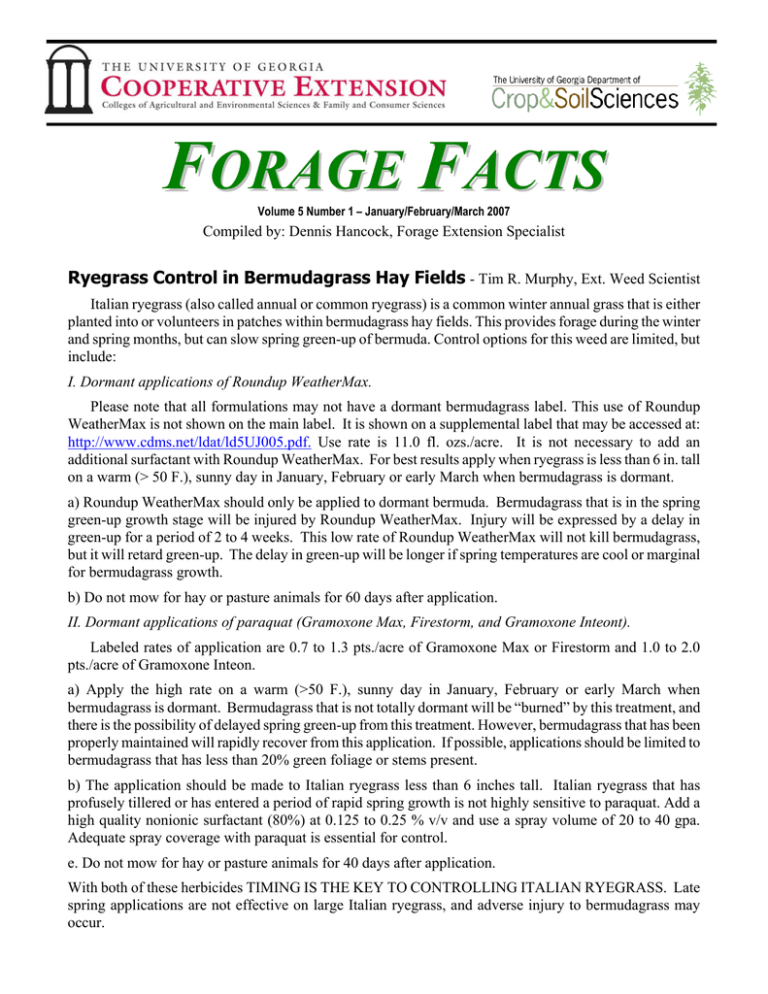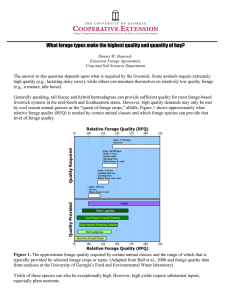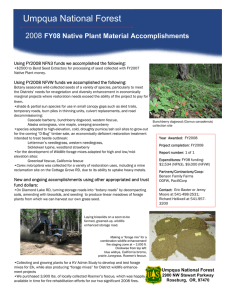FORAGE FACTS
advertisement

FORAGE FACTS Volume 5 Number 1 – January/February/March 2007 Compiled by: Dennis Hancock, Forage Extension Specialist Ryegrass Control in Bermudagrass Hay Fields - Tim R. Murphy, Ext. Weed Scientist Italian ryegrass (also called annual or common ryegrass) is a common winter annual grass that is either planted into or volunteers in patches within bermudagrass hay fields. This provides forage during the winter and spring months, but can slow spring green-up of bermuda. Control options for this weed are limited, but include: I. Dormant applications of Roundup WeatherMax. Please note that all formulations may not have a dormant bermudagrass label. This use of Roundup WeatherMax is not shown on the main label. It is shown on a supplemental label that may be accessed at: http://www.cdms.net/ldat/ld5UJ005.pdf. Use rate is 11.0 fl. ozs./acre. It is not necessary to add an additional surfactant with Roundup WeatherMax. For best results apply when ryegrass is less than 6 in. tall on a warm (> 50 F.), sunny day in January, February or early March when bermudagrass is dormant. a) Roundup WeatherMax should only be applied to dormant bermuda. Bermudagrass that is in the spring green-up growth stage will be injured by Roundup WeatherMax. Injury will be expressed by a delay in green-up for a period of 2 to 4 weeks. This low rate of Roundup WeatherMax will not kill bermudagrass, but it will retard green-up. The delay in green-up will be longer if spring temperatures are cool or marginal for bermudagrass growth. b) Do not mow for hay or pasture animals for 60 days after application. II. Dormant applications of paraquat (Gramoxone Max, Firestorm, and Gramoxone Inteont). Labeled rates of application are 0.7 to 1.3 pts./acre of Gramoxone Max or Firestorm and 1.0 to 2.0 pts./acre of Gramoxone Inteon. a) Apply the high rate on a warm (>50 F.), sunny day in January, February or early March when bermudagrass is dormant. Bermudagrass that is not totally dormant will be “burned” by this treatment, and there is the possibility of delayed spring green-up from this treatment. However, bermudagrass that has been properly maintained will rapidly recover from this application. If possible, applications should be limited to bermudagrass that has less than 20% green foliage or stems present. b) The application should be made to Italian ryegrass less than 6 inches tall. Italian ryegrass that has profusely tillered or has entered a period of rapid spring growth is not highly sensitive to paraquat. Add a high quality nonionic surfactant (80%) at 0.125 to 0.25 % v/v and use a spray volume of 20 to 40 gpa. Adequate spray coverage with paraquat is essential for control. e. Do not mow for hay or pasture animals for 40 days after application. With both of these herbicides TIMING IS THE KEY TO CONTROLLING ITALIAN RYEGRASS. Late spring applications are not effective on large Italian ryegrass, and adverse injury to bermudagrass may occur. Intake Rate on Annual Ryegrass - Dennis Hancock, Forage Extension Specialist Since it has been rather mild in Georgia so far this winter, the production of our winter annual forages will really help to compensate for low hay stocks for those producers who have integrated annual ryegrass, wheat, cereal rye, or other annuals into their winter forage base. But, since hay and forage supplies are so tight, many producers are closely monitoring forage allowances and intake. This prompts the inevitable question: “How fast are they eating it?” Of course, the answer is it depends on a number of factors. Let’s use beef cattle as an example and start by pointing out the differences in need between types of cows during this time of year. Fall-calving cows are still lactating, but their requirements have greatly dropped off by now. Spring-calving cows have very high requirements because they either have already or are about to calve. Cows that are dry and early in gestation will have low requirements. So, intake will differ based on the type of the animal that’s being fed. Yet, intake is mostly limited by the physical constraints on the amount that an individual can eat. Thus, the size of an animal is the main determining factor for total intake. As a result, intake is usually calculated by a percentage of the animal’s body weight (bw). Still, the most critical factor in estimating any animal’s intake is the amount of fiber in the forage. In fact, dry matter intake (DMI) is commonly calculated as a function of neutral detergent fiber (NDF) and, to a lesser degree, the amount of NDF that is digestible (NDFD). Figure 1 shows that as NDF decreases, DMI intake decreases. So, during this time of year (January/February) the annual ryegrass is relatively immature and low in NDF. As a result intake can be upwards of 3.5 - 4% of bw. Later, as the ryegrass gets more mature, NDF increases and the percentage drops below 3% of bw. Eventually (sometime in April), NDF will increase to about 55% and the amount of dry matter intake drops below 2% of bw. So, remember to consider all the factors when trying to estimate forage intake. Figure 1. The NDF values for annual ryegrass in late January (light green), mid-March (green), and April (dark green) in relation to the effect of NDF and NDFD on dry matter intake (as a % of body weight). NDFD = 45 4 NDFD = 40 NDFD = 35 3.5 3 2.5 1 0.5 0 30 40 April 1.5 Mid-March 2 Late January Dry Matter Intake (% of bw) 4.5 50 60 70 NDF (%) 2 Good Question! Because of the diversity of forage production in Georgia, there are always many good questions on a variety of topics. Here are some of the many good questions that have been fielded by our Forage Extension Team recently. “I’ve heard about a new species called Teff. How do you think it will do in Georgia?” Teff (Erogrostis tef) is a summer annual grass that is relatively high in quality. But, it is not new. In fact, teff has been grown in Africa for a long time, particularly in Ethiopia where the grain makes up a large portion of their diet. Its use as a forage crop in the Southeast is still being evaluated. In general, however, the forage productivity of teff (in terms of yield) is often 1/2 to 1/3 that of most other summer annual forages. Teff appears to do well on soils that low in fertility, but some of our other summer annuals can still out perform teff on poor soils. At this point, I would not recommend its use, at least until it has been studied a little more thoroughly. “How does the NEL (Net Energy for Lactation) of bermudagrass compare with other forage species?” Table 1 shows the “book values” for the NEL for several forage species. It is important to note that the actual NEL that your forage will provide depends on a variety of factors. For example, these book values rarely differentiate between varieties within a species, but it is known that the energy of Tifton 85 is generally higher than that of Coastal or common bermudagrass. In addition, differences in the harvest timing can also drastically influence differences between lots. Table 1. Expected values for net energy for lactation (NEL – cattle) for fresh samples (i.e., grazed) of selected forage species. Species NEL (Mcal/kg of DM) Bermudagrass 1.41 Sorghum-Sudan (non-BMR) 1.60 Annual Ryegrass 1.40 Alfalfa, Late Vegetative 1.37 “I’m having difficulty finding Cheyenne seed. Got any suggestions?” Cheyenne, a seeded bermudagrass variety, is a good performing seeded variety. However, it was not a very good seed producer. As a result, it has suffered the fate of many good varieties that can’t produce enough seed to meet demand: it got phased-out. But, there is good news for Georgia producers interested in seeded varieties. Cheyenne II, a new seeded variety that is very similar to Cheyenne (in terms of productivity and persistence) is being introduced, though seed supplies may be limited in 2007. In the meantime, Ranchero Frio (a blend of the ‘Cheyenne,’ ‘Mohawk, and ‘Giant’ seeded bermudagrass varieties) is a good alternative. One caution is that ‘Giant’ has been difficult to keep in the stand, but Dr. Carl Hoveland, Professor Emeritus of Forage Ecology at UGA, observed that ‘Cheyenne’ was able to fill in as ‘Giant’ thinned. 3 Research Highlights There are many research articles published that have findings that are important for forage producers in Georgia. In this section, the results of two recent research articles are adapted from their published abstracts. Grazing Influences on Mass, Nutritive Value, and Persistence of Stockpiled Jesup Tall Fescue without and with Novel and Wild-Type Fungal Endophytes – Burns et al., 2006. Crop Sci. 46:1898-1912. Introducing novel endophytes into tall fescue (Festuca arundinacea Schreb.) that produce no ergot alkaloids (alkaloids associated with fescue toxicosis) could prevent negative impacts on animal performance while improving plant persistence. This 3-yr study evaluated ‘Jesup’ tall fescue for forage mass, nutritive value, and stand persistence when containing no endophyte, a novel endophyte (no ergot alkaloids), or a wild-type endophyte (ergot alkaloids). Forage was stockpiled from mid-August and treatments consisted of (i) a grazed control (grazed when growth approximated 4 to 6 in.), or forage accumulated and grazed in (ii) mid-November, (iii) mid-December, (iv) mid-January, and (v) mid-February. Endophyte status had no influence on total forage mass; forage removed by grazing; proportion of leaf, stem, and dead fractions; or on nutritive value (except ergovaline which was greatest in the wild type). Delaying defoliation linearly reduced forage mass, ergovaline concentration, and nutritive value. All stands of tall fescue declined with losses similar (P =0.37) for wild-type and novel stands (29 vs. 42%) but were greatest for the tall fescue without an endophyte (29 vs. 75%; P 5 0.01 and 42 vs. 75%; P = 0.04). These data support the use of novel endophytes in tall fescue for animal production and caution against the use of endophyte-free tall fescue because of decreased stand longevity. The presence of ergovaline can be minimized by stockpiling tall fescue with utilization after late autumn but occurs with a sacrifice in forage mass and nutritive value. Spatial Heterogeneity of Herbage Response to Management Intensity in Continuously Stocked Pensacola Bahiagrass Pastures – Dubeux et al., 2006. Agron. J. 98:1453-1459. Redistribution of soil nutrients often occurs on grazed swards, but the effect of these changes on forage response is not well understood. A 3-yr study in Florida evaluated the effects of a wide range of management intensities on patterns of forage and soil nutrient responses in continuously stocked ‘Pensacola’ bahiagrass pastures. The three management intensities were: Low (~35 lbs/a and ~1 cow/calf per acre), Moderate (~110 lbs/a and ~2 cow/calf per acre), and High (~320 lbs/a and ~1 cow/calf per acre). Responses were measured in three zones based on distance from water (Zone 1, 0–8 m; Zone 2, 8–16 m; Zone 3, 16 m). The forage accumulated most slowly under Low intensity management but High and Moderate intensities did not differ in any year. Though the forage grew faster in Zone 1, total yield was lower in the zone closest to the water source during 2 of 3 yr. Forage quality increased with management intensity and was greatest in Zone 1 for Low, but not for the other intensities. Soil P, K, and Mg accumulated in Zone 1 of all management intensities. In all cases, soil nutrients became concentrated at zones nearest water sources and shade. This problem was worse when the pastures were under the less intensive management. 4



